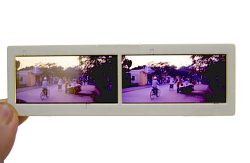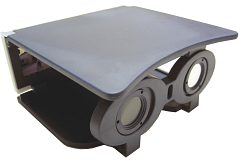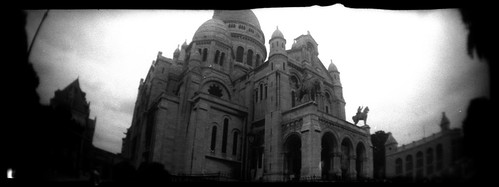In this last post of this year, I wish to mention about the handmade panoramic cameras I first came across, and which somewhat kindled my interest in panoramic cameras and panoramic photography in general.
I first saw these two cameras in Robert Monaghan's site about five years ago. These are handcrafted by eminent professional photographer Dirk Fletcher.
The camera at the left was made from three bodies of Pentax K1000 and fitted with a 65mm f/8 Super Angulon on a focusing mount which yields a 24cm x 4.5 inch original that could be printed in a 4x5 enlarger. The design and fabrication of this camera predates the Hasselblad Xpan. It took Mr. Fletcher a good amount of work to uncouple the clutch mechanism from the rewind mechanism of the K1000.
The bigger camera at the right is based on a 6x17 torpedo back with the front of 2x3 anniversary speed graphic that was fitted with a 90mm f/5.6 Schneider Super Angulon. It used a grip from a Linhof Technika three and a masked finder from a 25mm Canon rangefinder lens.
I thank Mr. Fletcher for allowing me to use this picture and for providing the details of construction of these two cameras.
To know more about Dirk Fletcher's work visit his website www.dirkfletcher.com
The camera at the left was made from three bodies of Pentax K1000 and fitted with a 65mm f/8 Super Angulon on a focusing mount which yields a 24cm x 4.5 inch original that could be printed in a 4x5 enlarger. The design and fabrication of this camera predates the Hasselblad Xpan. It took Mr. Fletcher a good amount of work to uncouple the clutch mechanism from the rewind mechanism of the K1000.
The bigger camera at the right is based on a 6x17 torpedo back with the front of 2x3 anniversary speed graphic that was fitted with a 90mm f/5.6 Schneider Super Angulon. It used a grip from a Linhof Technika three and a masked finder from a 25mm Canon rangefinder lens.
I thank Mr. Fletcher for allowing me to use this picture and for providing the details of construction of these two cameras.
To know more about Dirk Fletcher's work visit his website www.dirkfletcher.com
Mr. Fletcher also maintains an interesting blog http://dirkfletcher.blogspot.com on different technical and inspirational aspects of photography including camera modifications.
Last but not the least, I wish all visitors of this blog across the world a very happy new year. Thanks to you all, who supported this blog by providing pictures, information, comments and encouraging words. Thanks are particularly due to Olaf Matthes, Matt Sampson and Gildas Le Lostec.
















































